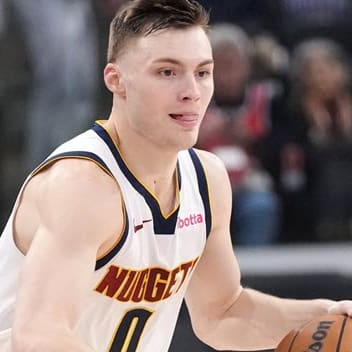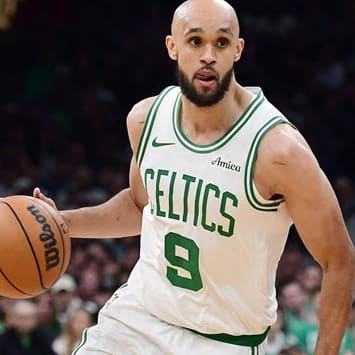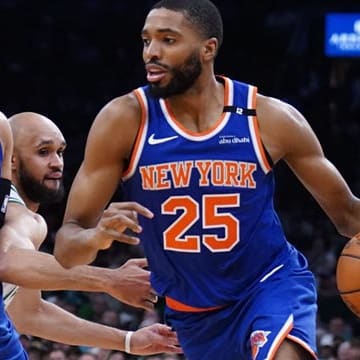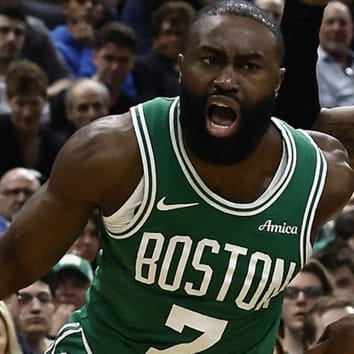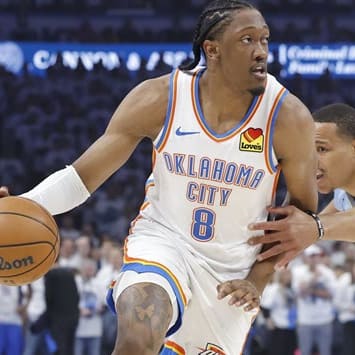Injury Update
By Jim Russo
RotoWire Injury Expert
Injuries are a fact of life in all sports, and NBA players certainly suffer their fair share. Here's a prognosis for some of the Association's biggest names, with a look at how last year's injuries may affect their status for 2008-09 and beyond.
Lower Extremity Injuries
Any discussion of NBA injuries always starts with the lower extremities. This is a league where even the smallest players are taller and more athletic - by a large margin - than the average Joe. The size of the players and the demands of the sport - jumping and running up and down the court for nearly nine months - take their toll, and the knees, ankles and feet of these incredible athletes usually bear the injury burden.Foot and Ankle Injuries
Monta Ellis - GS [PG, SG]One of the highest-profile injuries of the offseason was the high ankle sprain sustained by Warriors guard Monta Ellis… though the injury itself isn't the only cause for concern. More on that in a bit.
A high ankle sprain is a significant injury for any athlete, especially a basketball player. Ellis suffered the worst kind, one with an associated grade three sprain -- a complete tear -- of the deltoid ligament. Most of the ankle sprains we see in athletes are inversion sprains, when the ankle rolls onto the outside part of the foot. A high ankle sprain can result from an unusually bad inversion sprain but normally they result from an eversion sprain, when the foot rolls onto the arch side of the foot.
They're called "high" sprains because the injury disrupts the syndesmotic ligament, which is above the ankle joint and wraps around the lower end of the tibia and fibula, holding them together. When there's an injury to this structure, any weight bearing can cause the two bones to separate, which is extremely painful, and leads to a very unstable ankle. Eversion sprains also often cause injury to the deltoid ligament, a strong, triangular ligament on the inside part of the ankle. Ellis' injury was bad enough that he had a complete tear of the deltoid that required surgery to correct.
The early prognosis is that he'll miss at least three months, but with injuries of this nature, teams should always err on the side of caution, and give players time to fully recover before subjecting them to the daily grind of practicing and playing in the NBA. Whether or not it occurred in a pick-up game, as he contends, or in some other way, this is a significant injury. They do happen in basketball, but aren't nearly as most lower extremity injuries so it's difficult to speculate as to the validity of the story. If it's true that the rest of his leg was littered with cuts and abrasions -- that definitely adds doubt, unless of course we're to believe he was playing on an outside court strewn with glass and small pebbles. A lot of us have played on those courts but I'm not sure if a 23 year old NBA star -- who just signed a $66 million contract would be up for it.
Many suspect was engaged in some contractually-forbidden activity when he sustained the injury -- riding a motorcycle or dirt bike would be a good way to suffer this sort of sprain. That puts the team in a very difficult spot. If they come down too hard on their young star, he might wind up less motivated to commit to his rehab and get back quickly. On the flip side, he could push himself to come back too soon - to "make amends" - and wind up re-injuring himself. It will be interesting to see how this drama plays out.
Yao Ming - HOU [C]
Moving on to one of the biggest athletes in the world today, both literally and figuratively: Houston Rocket center Yao Ming. Yao's commitment to play with Team China as the host country at this summer's Olympic games has been well-documented elsewhere; here, we'll deal with the facts of his injury.
Last February, Yao shocked the basketball world with the announcement that he had a stress fracture in his left foot, and was going to miss the rest of the regular season. The injury was to his tarsal navicular bone, which lies on the inside back part of the foot, basically connecting the ankle to the mid foot.
A stress fracture is not an acute injury, but a chronic one that often takes weeks and months to develop starting with a dull aching pain and progressing to the point where even walking is excruciating. All bones in the human body, especially the weight-bearing bones in the lower leg and foot, are constantly being broken down by the body and built back up again. When the breaking-down part out-paces the building-up, stress fractures develop. If left untreated, they worsen and can eventually lead to non-union fractures, which rarely heal effectively without surgery.
Yao's fracture was apparently caught early enough that the prognosis for recovery was good, but he still had the operation to fixate the bone with a few screws across the fracture site. The surgery was his best chance of making it back in the shortest amount of time, obviously important with the Olympic Games quickly approaching.
He had the surgery in early March and after a period of immobilization and non-weight bearing, he was ready to resume training in June. By then end of that month, x-rays showed he was 80 percent healed, and he returned to light practice. You really can't ask for a better outcome than that. By the end of July, Yao was back in the lineup for his National Team, admittedly at less than 100%, but planning to play for his country.
To us, he's an example of everything you look for in a professional athlete and it all starts with the word commitment. We should be so lucky with some of the players who have taken the court for Team USA. That said, last year was the third straight season that injuries have limited Yao to under 60 games. The human skeleton just isn't designed to support a body the size and weight of Yao's - it seems clear that he'll be at risk for similar nagging injuries for the rest of his career.
Elton Brand - PHI [PF]
Brand is getting a new start in Philly this season. It should be a good one for the player who missed all but the last few weeks of 2007-08 with a complete tear of his Achilles' tendon.
Most know where the Achilles' is located; it connects the large muscles in the back of the lower leg to the calcaneus, or heel bone, and is essential for walking, let alone sprinting and jumping. The normal course of rehab in these cases is around six to eight months so, all things considered, Brand did very well to play at all last season. He still may have symptoms like pain and stiffness from time to time, but over the long course of the NBA season, few players don't. He could be a force in the Eastern Conference this year.
Knee Injuries
That brings us to knee issues - where we could spend the rest of the discussion without running out of things to say.
Greg Oden - POR [C]
First up, we have the number one pick in last year's draft, Greg Oden, who has yet to play a game in the NBA. Oden had surgery last September to repair an osteochondral defect (OCD) in his right knee. The injury is to the articular cartilage that covers the ends of long bones. This type of cartilage provides a smooth surface for bones that make up a joint, allowing easy movement of one bone on the other.
This is different from an injury to the meniscus - which we'll get to later. Even small defects or tears can't simply be removed; they require the dreaded microfracture surgery. Microfracture involves boring tiny holes in the area where the defect is located, in hopes that the resulting bleeding fosters growth of new tissue.
Despite the prognosis of at least 10-to-12 months' recovery time, there was reason for optimism. The defect was small, and Oden is young. Even with a whole year off, when he suits up for Portland this fall he'll only be 20, with a long career ahead of him. That said, the negatives however can't be ignored. This is still a relatively new procedure that isn't 100 percent effective (few are). The long-term affects are not clear yet. Amare Stoudemire of the Suns might be a good example of what to expect from Oden. Stoudemire had a similar procedure at a similar age and was able to come back, though his progress was spotty initially. Of course, most 20-year-olds playing in the NBA for the first time are inconsistent, even if they aren't recovering from significant knee injuries, so temper your expectations accordingly.
Derrick Rose - CHI [PG]
From last year's number one pick to this year's model: Rose caused some alarm in Chicago when he announced he was dealing with patella tendonitis in his right knee. Also known as "jumper's knee", the injury is drastically different than Oden's, but it can be problematic.
Tendonitis is almost always a chronic condition involving inflammation at the point a tendon attaches to a bone. In Rose's case it's affecting the attachment of the patella tendon, the structure which connects the large quad muscles in the thigh to the lower leg. Most, especially former athletes or runners, can feel the spot of attachment on the tibia, just below the kneecap.
He's had the problem for some time - it affected him at Memphis - but this is an injury half the players in the league deal with at some point in their careers and is highly treatable. Surgery is usually not required until all else fails (more on this later). If treated properly, he should be fine. But this will bear watching over the course of the season because virtually all rookies "hit the wall" at some point early in their careers. With an injury like this one, Rose may hit that wall a little harder, because rest is really the best treatment, and that's not easy to come by in the middle of an 82-game schedule. He was able to play for the USA select team this summer shortly after the initial diagnosis, so everything points to him starting the year healthy.
Andrew Bynum - LAL [C]
Bynum suffered a knee injury last January that may have cost the Lakers the NBA title - a subluxed patella and bone bruise in his left knee. A subluxation is a temporary dislocation - basically the kneecap popped out of the groove it normally occupies in the lower part of the femur and then popped back in. The bone bruise resulted from the kneecap making contact with the side of that groove as it left the joint and then again as it came back in. The posterior - back side - of the patella, and the anterior - front - of the lower part of the femur have some of that articular cartilage we mentioned earlier, which can be damaged when the patella subluxes. That, along with a tremendous amount of swelling and pain, more than explains why Bynum's diagnosis was bleak from the begining.
Bynum and the team did everything possible to get him back in the lineup for the playoffs but it just wasn't to be, so he had an arthroscopic debridement surgery in May to clean up the joint and remove any loose particles or fragments from the injured cartilage. When he finishes his rehab, usually a three or four month process, he should be pain-free and ready to help the Lakers get back to the top of the Western Conference. However, as with any injury, questions will remain. Some players are more prone to these injuries because that groove in the femur is shallower than normal. We're not saying that's the case here - we haven't seen anything to indicate it - but you never know.
Gilbert Arenas - WAS [PG]
Arenas has been plagued by a knee injury that cost him a large portion of the last two seasons. That didn't stop the Wizards from offering him a six-year contract, but it is definitely one to watch going into this year's draft.
Arenas initially tore the lateral meniscus in April '07 and had a scope to repair the cartilage. There are two menisci in each knee, medial (inside) and lateral (outside). They're shaped like half moons and occupy the space between the femur and tibia. They help stabilize the knee joint during activity, but their main purpose is to cushion and absorb shock.
There are many kinds of meniscus tears. The type and precise location, dictate what surgeons will do to fix them. Minor tears are often just removed as the remaining tissue is still functional. More serious ones need to be repaired, or tacked down so there is still some cushioning material left in the knee. The rehab is much more difficult in these cases, and the resulting time away is much longer.
There aren't many details available on the precise surgery Arenas had initially, but we'd guess from the amount of time he missed that it was a repair. That he had it drained a few times last preseason and eventually needed another scope in November to clean up the meniscus backs that up. He also reportedly had some microfracture done to a non-weight bearing potion of the bone in that area. Then the waiting game began again until he eventually made it back to the lineup in April. The optimism associated with his return was essentially squashed when he couldn't finish the Wizards' playoff series against the Cavs due to pain in the knee.
The thing that gets us is he still decided to opt out of his contract, after missing the better part of a full calendar year and then got the offer for six more. We should all be so lucky. Either way, there're a couple things to take from this. You have a very talented player with a tremendous upside all across the stat sheet, who was just given a huge contract, and should be ready to go this pre-season. Obviously the Wizards believe in him - but he's also had two knee operations in the last 18 months and was still having symptoms months after the second procedure. We would be wary of that history, no matter who the player is.
Danilo Gallinari - NYK [SF/PF]
Another player taken in the top 10 of last June's draft, Italian forward Gallinari had some trouble with his lower back in his first and only game for the Knicks this summer. As with the knees, the size of NBA players and their style of play place a tremendous amount of strain on the back. There can be stress fractures in the lower back, but we also see disc problems, muscle strains, and the simple, yet annoying spasms. Gallinari's case is somewhat obscure - most back injures are - because all reports point to nothing significant, but he did sit out the rest of the summer league and was asked by the team not to compete in the Olympics.
We would draft him with caution because you never really know how young players, especially those with questions about injuries and toughness, will translate into the NBA. And if that doesn't scare you enough, the Knicks' history drafting European big men should.
Upper Extremity Injuries
Upper extremity injuries are also common in the NBA. You'll see everything from sprained fingers and wrists to elbow hyperextensions and shoulder dislocations. Most of these result from playing defense or from life under the basket, specifically rebounding, where the contact can be fierce.
Kobe Bryant - LAL [SG]
Bryant had one of those injuries defending Jason Kidd when he got his hand caught in Kidd's jersey and hyperextended his right pinky finger at the metacarpophalageal (MCP) joint. The joint is the one that connects the finger to the hand, and the injuries are to the volar plate, a thick ligament on the palm side of the joint which prevents hyperextension of the finger, the radial collateral ligament, which is between the 4th and 5th fingers and prohibits movement of the pinky away from the rest of the hand, and a small avulsion fracture.
An avulsion fracture occurs when a piece of connective tissue, usually a ligament, tears a small piece of bone off its body. The ligament doesn't tear - the bone does. These injuries rarely heal well without surgery because the displaced fragment of bone will never find its way back to that spot where it should be, instead kind of floating around in that piece of tissue it was attached to.
Bryant recently announced that he'll forego surgery on the finger -- at least until after the season. Obviously, with the way Kobe finished the regular season and playoffs and played in China, he was able to deal with the pain. Without fixation however, he would have a degree of instability in the finger. It's his pinky finger, the least important in terms of overall strength so that's always a positive.
Dwyane Wade - MIA [SG]
A couple of the brightest stars in the game today are recuperating from multiple injuries to both their upper and lower extremities. In May 2007, Wade had surgeries on both his left knee and shoulder, and struggled to regain his form through most of last season.
The shoulder surgery was to repair a torn labrum, suffered initially in February '07 when he dislocated his shoulder playing defense. When the shoulder pops out of the joint, the labrum - the cartilage that surrounds the joint adding depth and stability to the structure -
is often torn, which leaves players susceptible to future dislocations. (You may remember Mel Gibson using this to his advantage in the Lethal Weapon movies.)
This is another cartilage injury that usually will not heal without surgery. Players will often attempt a course of rest and rehab to strengthen the muscles around the shoulder, but certain movements - usually reaching overhead or out to one's side - still cause pain and apprehension that it will pop out again. Needless to say, if a basketball player doesn't have confidence reaching out with his shoulder, he has a problem.
The knee surgery was a debridement of his patellar tendon, the large tendon in the front of the knee that anchors the quad to the lower leg. Same structure as Derrick Rose, but Wade's surgery was the result of a few more years of abuse, leading to a more beat-up tendon. He was plagued by both injuries throughout the season, not making it back to the lineup until mid-November, and he eventually needed to shut it down in March to hopefully put it all behind him.
(The Heat's record at the time may have had something to do with the decision, but either way it was in his best interest long-term.)
By June Wade was added to the USA Basketball roster and was able to take part in full practices by the end of that month. Even with the trouble he had last year, most of his numbers still were close to his career averages, with the exception of free-throw attempts, but that make sense as players often avoid contact when battling pain. Recently he's been starting for Team USA, so I think it's safe to expect a solid return to form this season for Wade.
Tracy McGrady - HOU [SG/SF]
Another player scheduled for a lot of rehab time this summer was McGrady. He had similar procedures performed on his left shoulder and knee after the Rockets' playoff loss to Utah. McGrady has battled more than his share of injuries over the years: the two I just mentioned, plus elbow problems and back spasms that have reared their ugly head a few times in his career.
He can still be one the most productive players in the game when healthy; you don't have to look any further than the 40 he put up in the last game of the Jazz series for indication. He hasn't been heard from much this offseason, but he should be healthy for training camp.
McGrady's desire to get back on the court and the numbers he's able to put up may be bolstered by the team's acquisition of Ron Artest. It will take a lot of the defensive responsibility away from T-Mac, which never hurts, but Artest will also open up the offensive side of the floor for their number one option from the perimeter.
Ron Artest - HOU [SF]
Artest had a couple injuries of his own to deal with last season: a left thumb sprain - which may be an aggravated repair of an old torn ligament - and bone chips in his elbow.
The bone chips result from chronic wear and tear on a joint, leading to small cartilage fragments breaking off and more or less getting stuck inside the joint. They can be extremely painful depending on where they end up. Both issues required surgery but shouldn't slow him down going forward in '08-09. Artest still put up solid numbers last season, and with renewed motivation (how many times have you heard that?) and better offensive options around him, that trend could continue.
Jim Russo is a certified athletic trainer with a Master's Degree in Exercise Physiology.
Article first appeared on 9/11/08






